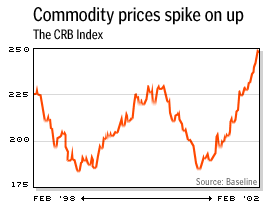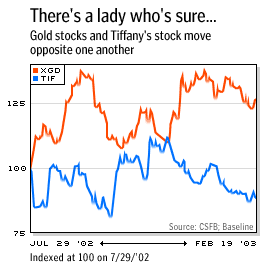NEW YORK (CNN/Money) -
Don't look now, but rising goods costs could be putting corporate profits in a vise.
Wall Street got a shock Thursday when the Labor Department reported that wholesale prices in January had registered their biggest rise in a 13 years. The producer price index skipped 1.6 percent higher, way more than the 0.5 percent gain economists expected.
| Related Stories
|

|
|
|
|
Nor was that a higher-oil-price story -- take out the food and energy sectors and the PPI still registered a whopping 0.9 percent gain.
Naturally the jump set tongues wagging about how inflation is just around the corner. But for investors the real worry is that those costs are eating into profits.
The problem is that companies can't pass those costs to consumers, "You can see a margin squeeze there," said Northern Trust chief U.S. economist Paul Kasriel. "Higher prices are making it into the pipeline, but they're not making it to the faucet."
Commodity prices already way up

If you look at what's been going on with commodity prices, the gain in the PPI has been a long time coming. The Commodity Research Bureau's index of commodity prices has been gaining ground and has recently ticked to its highest level in over five years.
Higher oil prices are partly responsible -- but not completely. Commodity prices from cotton to cocoa to steel scrap have been jumping. The Economist's commodity price index, which excludes energy and precious metal prices, has risen 16.8 percent in the past year.
It takes time for companies to pass on those price increases. This is particularly true in a soft economic environment where skittish consumers are unwilling to pay more. Think of the way airlines (a special case, to be sure) have been unable to raise ticket costs even as fuel costs have skyrocketed.

Or, to take another example, look at Tiffany (TIF: Research, Estimates). Credit Suisse First Boston quantitative strategist Ryan Renicker has pointed out the jeweler's stock price has been moving in the opposite direction of the XGD, an exchange-traded fund of gold stocks on the Toronto stock exchange. Why?
Renicker thinks it may be because investors recognize that Tiffany customers have other high-end goods to choose from -- if Tiffany tried to pass on the big jump in gold prices, customers might just opt for a Chanel bag.
Sign of improvement
After years of struggling with too much capacity and, thus, very little pricing power, crude goods suppliers (i.e., steel producers) are in a much better position now, according to Mizuho Securities U.S.A. strategist John Vail.
"Raw materials producers are lean and mean after years of being squeezed," he said. The result is that they are in sellers' markets, and are able to raise prices.
The producers further along the food chain, on the other hand, have yet to finish cleaning up the excesses they ran into during the late 1990s, which means they cannot pass along higher costs to their customers.
According to the Federal Reserve, producers of crude goods are running at 83 percent of capacity compared with a 30-year average of 86 percent. But producers of finished goods are running at just 71 percent of capacity compared with a 30-year average of 79 percent.
"There's still quite a bit of slack in the economy, and you can't push through prices until you eliminate that slack," said Richard Berner, chief U.S. economist at Morgan Stanley.
Still, one needn't be entirely glum. For Berner the jump in the PPI, after it had been muted for so long, was a hopeful sign, showing that the increases in crude costs passed up to the next level of the food chain, that the excesses are getting worked out and that economic health will, eventually, return.

|

